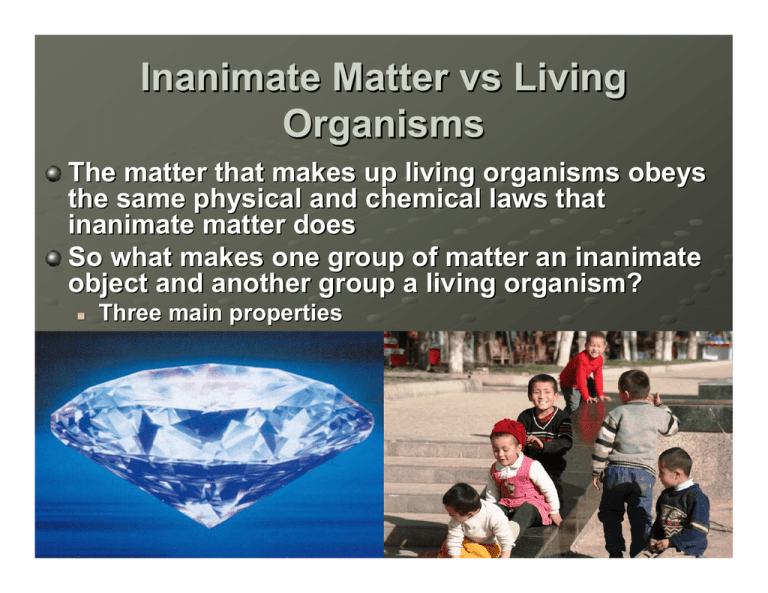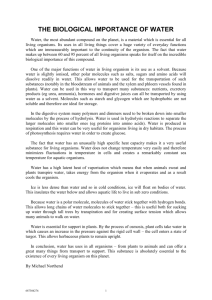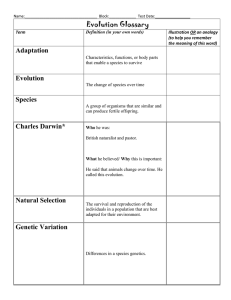Inanimate Matter vs Living Organisms
advertisement

Inanimate Matter vs Living Organisms The matter that makes up living organisms obeys the same physical and chemical laws that inanimate matter does So what makes one group of matter an inanimate object and another group a living organism? Three main properties Property #1 Living organisms exhibit a high degree of chemical complexity and organization Thousands of different molecules make up a single cell’s intricate internal structure Thousands of other molecules allow the cell to perform its general and specific functions in such a way that the life of the organism continues Biomolecules Biomolecules are the chemicals present in living organisms Almost all biomolecules are organic molecules Carbon-based chain or ring molecular structures Most biomolecules are macromolecules A molecule having a molecular weight in the range of a few thousand to many millions Molecular Weight Mr A dimensionless ratio of the mass of a molecule to 1/12th the mass of 12C Molecular Mass Can be expressed in terms of the units of daltons (Da) or atomic mass units (amu) 1 Da=1.66x10-24g (mass of a single hydrogen atom) Four Major Classes of Bio-Macromolecules 1. Carbohydrates 2. Lipids 3. Proteins 4. Nucleic Acids Bio-Macromolecule Monomers and Polymers Bio-Macromolecule Monomers H2O Monosaccharides Simple Lipids Amino Acids Nucleotides Bio-Macromolecule Polymers Polysaccharides Dehydration Synthesis Hydrolysis Complex Lipids Proteins H2O Nucleic Acids Number of different sequences possible for a biomacromolecule is determined by the equation S=NL, where S is the # of different sequences possible, N is the # of different kinds of monomeric subunits available, and L is the length of the linear sequence Body Composition The major types of molecules in a person weighing 145 lbs (66 kg) will be approximately as follows: Constituent Protein Carbohydrate Fat Water Minerals Nucleic Acids Pounds 25 2 20 89 9 - Percent 17 1.4 14 61 6 <1 Of these constituents, the ones most subject to change are the fat and water content. Only about 2 lbs of the above fat is essential. On the other hand, most of the protein and carbohydrate is essential although there are reserves which can be drawn upon. The body can lose about 10 percent of its total water and at least a third of the mineral content without serious consequences. The average fat content in women is about twice that in men and in both sexes increases with age. Nucleic acids constitute less than 1% of the total body weight Property #2 Living organisms extract, transform, and use energy from their environment Usually obtained in the form of chemical nutrients and/or sunlight This energy allows organisms to build and maintain their intricate structures This energy also allows organisms to do mechanical, chemical, osmotic, and other types of work Inanimate matter does not use energy to maintain structure or do work It tends to move towards greater disorder until equilibrium with the surroundings is achieved Biochemical Energy Cycle Energy and Biochemistry According to the science of physics, energy is defined as the ability to do work Energy is a central issue in the study of biochemistry Cells and organisms depend on a constant supply of energy to oppose the inexorable tendency in nature for a system to decay to its lowest possible energy state and highest state of disorder (entropy) Cells contain highly efficient mechanisms for coupling the energy obtained from sunlight or fuels to the many energy-consuming processes they carry out Bioenergetics The study of the energy transformations and exchanges on which all living organisms depend Biochemistry examines the processes by which energy is extracted, channeled, and consumed in order for living organisms to do work Living cells and organisms must perform work to stay alive and to reproduce Chemical Work—Biosynthesis Osmotic Work—Accumulation of salts and organic molecules against a concentration gradient Mechanical Work—Muscle contraction; bacterial flagellum motion ** Organisms vs. Environment Living organisms are open systems** They exchange both matter and energy with their surroundings However, living organisms are not at equilibrium with their surroundings The molecules and ions within a living organism differ in kind and concentration from those in the organism’s surroundings Equilibrium with surroundings = death The death and decay of the organism restores equilibrium In order to maintain this critical difference, living organisms must constantly extract and use energy from sunlight and/or food to build complex molecules and to concentrate necessary ions ** Dynamic Steady State Even though the chemical composition of an organism is almost always constant through time, the population of molecules within a cell/organism is far from static Molecules are synthesized and then broken down by continuous chemical reactions, involving a constant flux of mass and energy through the system The amounts of most molecules remain nearly constant because the rate of their synthesis or intake just balances the rate of their breakdown, consumption, or conversion into some other product This constancy of concentration is the result of a dynamic steady state A nonequilibrium state of a system through which matter is flowing and in which all components remain at a constant concentration Steady State Example #1 Precursors (amino acids) Synthesis r1 Hemoglobin (in erythrocytes) Degradation r2 When r1=r2, the [hemoglobin] is constant. This is a steady state situation. Breakdown products (amino acids) ** Steady State Example #2 Food Ingestion (carbohydrates) r1 Glucose (in blood) Utilization r2 Waste CO2 r3 Storage Fat r4 Other Products When r1=r2+r3+r4, the [glucose] in the blood is constant. This is a steady state situation. Energy Coupling Links Reactions in Living Organisms Free Energy (G) The amount of energy actually available to do work Free Energy Change (∆G) The amount of G gained or lost in a chemical reaction as it moves towards equilibrium without any changes in temperature and pressure Endergonic Reaction A chemical reaction that requires the addition of energy to reach equilibrium (+∆G) Reactions are non-spontaneous Exergonic Reaction A chemical reaction that releases energy to reach equilibrium (∆G) Reactions can occur spontaneously Cells couple exergonic processes to endergonic ones in order to drive normally unfavorable processes Metabolism The full complement of chemical reactions that occur in living organisms to maintain life Driven by enzymes Protein molecules responsible for the catalysis of all chemical reactions in living organisms Metabolic reactions are tightly regulated and coordinated Two main divisions 1. Catabolism Metabolic pathways responsible for the breakdown of molecules and production of energy 2. Anabolism Metabolic pathways responsible for the formation of larger molecules in an energydependent process ATP: The Universal Biological Energy Currency ** Property #3 Living organisms have the capacity for precise selfreplication and selfassembly This occurs at: The molecular level Replication of DNA The cellular level Mitosis, Meiosis The organismal level Sexual Reproduction This almost always occurs with near perfect fidelity The Key to Property #3: DNA, The Genetic Material At the Molecular Level… “The Central Dogma of Biology” At the Cellular Level… Cell Cycle and Cell Division ** Mitosis Cellular Differentiation At the Organismal Level… Childbirth Embryogenesis Organogenesis **



